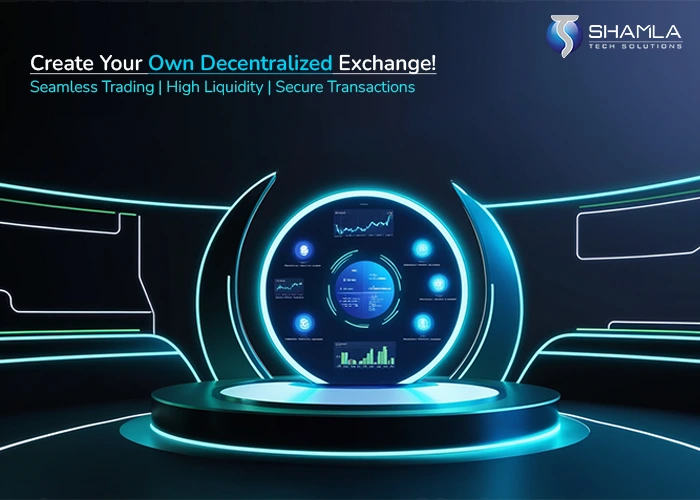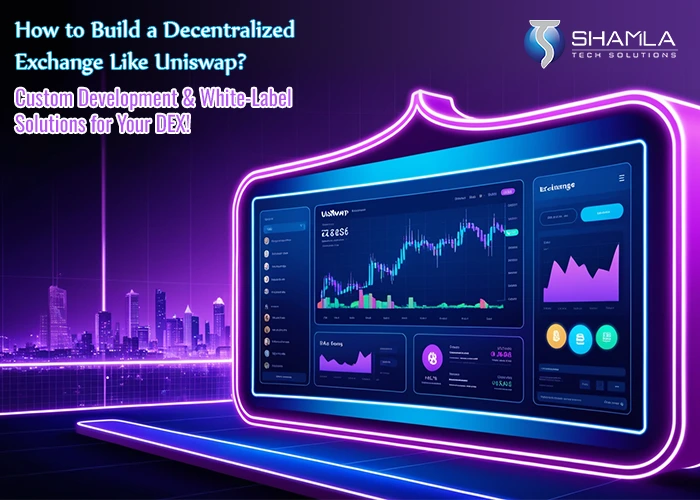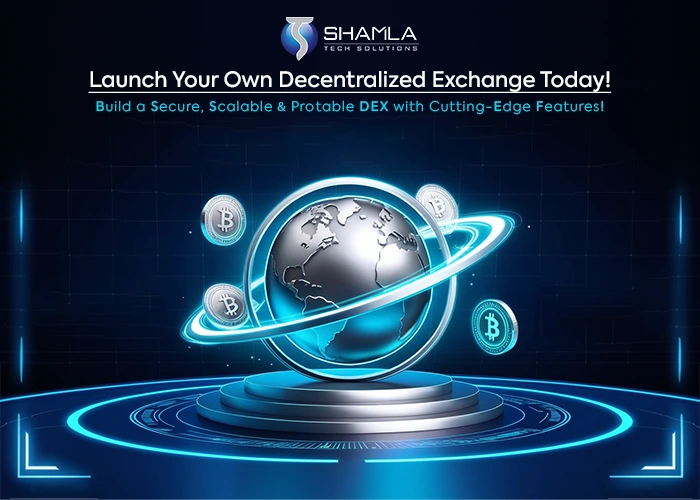With the rise of decentralized finance (DeFi), many businesses and developers are exploring how to launch a Decentralized Exchange to revolutionize crypto trading. A Decentralized Crypto Exchange Platform eliminates intermediaries, offering enhanced security, transparency, and user control. If you’re wondering how to launch a Decentralized Exchange, this guide will walk you through the essentials of Decentralized Exchange development.
Understanding how to create a Decentralized Exchange is crucial for success. Whether you want to build your own Decentralized Exchange like Uniswap or partner with a Decentralized Exchange Software Development Company, knowing the key components is essential. From integrating the best Decentralized Crypto Wallet to ensuring liquidity, every step impacts the platform’s success.
If you’re ready to create your own Decentralized Exchange, this article will provide expert insights into how to launch a Decentralized Exchange efficiently. Let’s explore the process of how to launch a Decentralized Exchange and bring your vision to life!

What is a Decentralized Exchange (DEX), and How Does it Differ from a Centralized Exchange?
If you are exploring how to launch a Decentralized Exchange, it is crucial to understand the fundamental differences between a Decentralized Crypto Exchange Platform and a traditional centralized exchange (CEX). A DEX (Decentralized Exchange) enables peer-to-peer trading of digital assets without intermediaries, making transactions more secure, transparent, and censorship-resistant.
How Does a Decentralized Exchange Work?
A Decentralized Crypto Exchange Platform operates on blockchain technology and smart contracts, allowing users to trade assets directly from their wallets. Unlike centralized exchanges, which act as intermediaries, a DEX removes the need for third parties, enhancing security and reducing hacking risks.
Key features of a DEX include:
- Non-custodial Trading – Users retain control of their funds using the best Decentralized Crypto Wallet.
- Smart Contracts – Automate transactions without human intervention.
- Liquidity Pools – Facilitate trading without a traditional order book system.
Difference Between Decentralized and Centralized Exchanges
If you’re researching how to launch a Decentralized Exchange, you need to understand how it differs from a CEX (Centralized Exchange):
Feature | Centralized Exchange (CEX) | Decentralized Exchange (DEX) |
Control Over Funds | Managed by the exchange | Users control their assets |
Security Risks | Prone to hacks and breaches | More secure with private wallets |
Regulations | Subject to KYC/AML compliance | Often operates anonymously |
Liquidity | High due to centralized control | Relies on liquidity providers |
Speed | Faster transactions | Slightly slower due to blockchain confirmation |
Why Businesses Are Exploring How to Launch a Decentralized Exchange
Many crypto entrepreneurs want to create their own Decentralized Exchange due to the increasing demand for decentralized trading solutions. Working with a Decentralized Exchange Software Development Company helps businesses efficiently execute Decentralized Exchange development while integrating innovative features.
Understanding how to launch a Decentralized Exchange is the first step toward building a secure and efficient crypto trading platform. Whether you aim to create your own Decentralized Exchange or collaborate with a Decentralized Exchange Software Development Company, careful planning is crucial.
With the increasing popularity of DeFi, knowing how to launch a Decentralized Exchange can give businesses a competitive edge in the blockchain industry.
How to Launch a Decentralized Exchange: 7 Essential Things You Need to Know
Decentralized exchanges (DEXs) are transforming the crypto landscape, offering users secure, transparent, and peer-to-peer trading solutions. If you are looking to enter this growing market, understanding the key elements of how to launch a Decentralized Exchange is crucial. In this article, we will walk you through the seven essential things you need to create your own decentralized exchange successfully.
1. Define Your Decentralized Exchange Model
Before you dive into Decentralized Exchange development, decide on the type of DEX you want to build. The main types include:
- Automated Market Makers (AMM) – Used by platforms like Uniswap, where smart contracts facilitate liquidity pools.
- Order Book DEX – Similar to centralized exchanges but operates with decentralized technology.
- Hybrid DEX – A mix of centralized and decentralized features for better efficiency and security.
Understanding these models will help you determine how to create a Decentralized Exchange that aligns with your business goals.
2. Choose the Right Blockchain for Your DEX
Selecting a blockchain platform is a critical step in how to build a Decentralized Exchange like Uniswap. Some popular blockchain networks for DEX development include:
- Ethereum (ERC-20 tokens) – The most widely used blockchain for DeFi applications.
- Binance Smart Chain (BSC) – Lower fees and faster transactions compared to Ethereum.
- Solana – High-performance blockchain for decentralized applications.
Your choice of blockchain will impact transaction speed, fees, and security for your Decentralized Crypto Exchange Platform.
3. Develop Smart Contracts for Secure Trading
Smart contracts are the backbone of any DEX. They facilitate secure, trustless transactions by executing trades automatically. Working with an experienced Decentralized Exchange Software Development Company ensures that your smart contracts are secure, efficient, and audited for vulnerabilities.
4. Integrate the Best Decentralized Crypto Wallet
A Best Decentralized Crypto Wallet is essential for users to store and trade their assets securely. Some popular wallets compatible with DEXs include:
- MetaMask
- Trust Wallet
- Coinbase Wallet
Ensure that your platform supports seamless wallet integration to enhance the user experience.
5. Implement Liquidity Solutions
Liquidity is crucial for the success of any DEX. Consider these methods to attract liquidity providers:
- Liquidity Pools – Encourage users to deposit assets in return for rewards.
- Staking & Yield Farming – Offer incentives for users who contribute liquidity.
- Market Maker Incentives – Partner with traders and investors to ensure liquidity on your platform.
Proper liquidity solutions will help your platform thrive in a competitive market.
6. Ensure Compliance and Security Measures
Although DEXs operate in a decentralized manner, legal and security compliance is essential. Key aspects to consider include:
- Regulatory Compliance – Research the legal requirements in your target market.
- KYC/AML Policies – Some DEXs choose to implement optional KYC for enhanced security.
- Audits & Penetration Testing – Conduct regular audits to eliminate vulnerabilities and protect user funds.
A secure Decentralized Crypto Exchange Platform will build trust and attract more users.
7. Launch, Market, and Scale Your DEX
Once your platform is ready, the next step in how to build your own Decentralized Exchange is launching and promoting it effectively. Consider these strategies:
- Community Engagement – Leverage social media, forums, and influencer marketing to promote your DEX.
- Airdrops & Incentives – Offer early adopters rewards for using your platform.
- Partnerships – Collaborate with blockchain projects and liquidity providers for expansion.
Scaling your platform with continuous updates, new token listings, and enhanced user features will ensure long-term success.
Understanding how to launch a Decentralized Exchange requires careful planning, development, and execution. From selecting the right blockchain to implementing smart contracts and ensuring security, each step plays a vital role in the success of your DEX. Whether you’re aiming to create your own Decentralized Exchange or looking for a Decentralized Exchange Software Development Company to assist you, focusing on these seven essential factors will set you on the path to building a successful and secure trading platform.
Are you ready to take the leap into Decentralized Exchange development? Start your journey today and revolutionize the crypto trading industry!

How Much Does It Cost to Build a Decentralized Exchange?
If you’re wondering how to launch a Decentralized Exchange, one of the first things to consider is the cost. The total investment depends on several factors, including Decentralized Exchange development, security features, blockchain infrastructure, and user interface complexity.
Key Factors Affecting the Cost of How to Launch a Decentralized Exchange
- Features and Functionalities
The cost of Decentralized Exchange development depends on the functionalities you want to include. A basic Decentralized Crypto Exchange Platform with simple token swaps will cost significantly less than an advanced system with liquidity pools, governance mechanisms, and advanced smart contract logic.
- Basic Trading Features – Standard token swapping and order matching.
- Advanced Features – Yield farming, staking, lending, and governance.
- Best Decentralized Crypto Wallet integration for seamless transactions.
- Security and Compliance
Security is one of the most crucial aspects of how to launch a Decentralized Exchange. A Decentralized Crypto Exchange Platform must include robust security protocols like smart contract audits, multi-signature authentication, and anti-money laundering (AML) mechanisms.
- Smart contract security audits to prevent vulnerabilities.
- Regulatory compliance based on the jurisdiction.
- Decentralized Exchange Software Development Company consultation for legal guidance.
- Blockchain Network and Technology Stack
The blockchain you choose plays a crucial role in how to launch a Decentralized Exchange. Different networks have different transaction costs, scalability features, and interoperability solutions.
- Ethereum-based DEXs like how to build a Decentralized Exchange like Uniswap require high gas fees.
- Binance Smart Chain (BSC) or Polygon-based exchanges can lower costs.
- Cross-chain integration increases complexity but enhances liquidity.
- Development Approach: Pre-Built vs. Custom Solutions
Another important factor in how to launch a Decentralized Exchange is whether you opt for pre-built solutions or custom development.
- White-label solutions – Faster and more affordable but with limited customization.
- Custom-built solutions – Require more time and investment but offer full control.
- Liquidity and Market Making
Liquidity is essential for the success of any Decentralized Crypto Exchange Platform. A new DEX needs strategies like automated market makers (AMM) and external liquidity providers to ensure smooth trading.
- Liquidity pool incentives to attract traders.
- Best Decentralized Crypto Wallet support for seamless deposits.
- UI/UX and Frontend Development
A user-friendly interface is critical in how to launch a Decentralized Exchange successfully. A well-designed DEX must offer an intuitive trading experience.
- Responsive and easy-to-use trading interface.
- Customizable dashboards for real-time price updates.
- Support for multiple blockchain networks.
- Ongoing Maintenance and Upgrades
Even after launching a Decentralized Exchange, maintenance is necessary. Regular updates, bug fixes, and security enhancements keep the platform running smoothly.
- Smart contract upgrades for security patches.
- Adding new tokens and trading pairs.
- Continuous compliance with evolving regulations.
There is no fixed cost for how to launch a Decentralized Exchange as multiple factors influence development expenses. Whether you choose to create your own Decentralized Exchange from scratch or work with a Decentralized Exchange Software Development Company, the cost will vary based on your needs.
Would you like expert assistance in how to build your own Decentralized Exchange? Reach out to Shamla Tech, a trusted Decentralized Crypto Exchange Platform provider today!
What Are the Legal and Regulatory Considerations When Launching a DEX?
If you’re exploring how to launch a Decentralized Exchange, understanding the legal framework is crucial. Unlike centralized exchanges, DEXs operate in a decentralized manner, but they still face regulatory scrutiny.
Key Legal Considerations for Decentralized Exchange Development
- KYC & AML Compliance
Although most Decentralized Crypto Exchange Platforms prioritize anonymity, some jurisdictions require Know Your Customer (KYC) and Anti-Money Laundering (AML) measures. Depending on your target market, implementing optional KYC solutions might be necessary.
- Licensing and Registration
To create your own Decentralized Exchange, you may need to register with financial authorities depending on your operational region. Some countries have stricter regulations, while others allow more flexibility.
- Taxation and Reporting
When learning how to launch a Decentralized Exchange, understanding crypto taxation laws is essential. Some governments require reporting of decentralized transactions, while others have unclear policies.
- Security and Consumer Protection
Building trust in your Decentralized Crypto Exchange Platform means ensuring secure transactions and addressing potential risks. Working with a Decentralized Exchange Software Development Company can help ensure compliance with best security practices.
Understanding how to build your own Decentralized Exchange with proper legal guidance ensures long-term sustainability and global accessibility.
How Long Does It Take to Develop and Launch a DEX?
If you’re eager to know how to launch a Decentralized Exchange, understanding the development timeline is crucial. The duration depends on platform complexity, smart contract functionality, security audits, and UI/UX development.
Development Timeline for a Decentralized Exchange
- Planning and Research
Before you create your own Decentralized Exchange, extensive research and planning are required. This includes selecting a blockchain, defining features, and analyzing competitors.
- Smart Contract and Blockchain Development
To build your own Decentralized Exchange, robust smart contracts need to be developed and tested. Security audits and bug fixes are critical in this phase.
- Frontend and Backend Development
Creating an intuitive Decentralized Crypto Exchange Platform involves designing a seamless UI, integrating trading functionalities, and optimizing performance.
- Security Testing and Audit
Security is a top priority when learning how to launch a Decentralized Exchange. Extensive testing, code audits, and penetration testing ensure a hack-proof platform.
- Beta Testing and Deployment
Before the official launch, a beta version allows real-world testing. Early adopters can provide feedback, ensuring a smoother user experience.
The overall timeline for how to launch a Decentralized Exchange varies, typically ranging from 2 to 6 months. By partnering with a Decentralized Exchange Software Development Company, you can accelerate the process while ensuring a secure and fully functional DEX.
Should I Build a DEX from Scratch or Use a White-Label Solution?
When considering how to launch a Decentralized Exchange, one of the primary decisions is whether to build it from scratch or leverage a white-label solution. Each option has distinct advantages and challenges, depending on factors like budget, development resources, and business objectives.
Building a DEX from Scratch: Full Control, Higher Investment
Building a Decentralized Crypto Exchange Platform from the ground up provides full customization and flexibility. You can integrate innovative trading mechanisms, security enhancements, and Best Decentralized Crypto Wallet solutions tailored to user needs. However, this approach requires:
- Extensive Smart Contract Development – Writing and auditing smart contracts for automated trading and liquidity management.
- Robust Security Architecture – Preventing vulnerabilities like front-running and flash loan attacks.
- Scalable Infrastructure – Ensuring the platform can handle high transaction volumes without congestion.
- Liquidity Management – Developing strategies to attract liquidity providers to the ecosystem.
- Regulatory Compliance – Aligning with global and regional crypto regulations.
A fully custom-built Decentralized Exchange development process typically takes months and requires expert blockchain developers, security analysts, and UI/UX designers.
Using a White-Label Solution: Faster Deployment, Lower Costs
A white-label solution allows you to create your own Decentralized Exchange with pre-built components. Many Decentralized Exchange Software Development Companies offer ready-made platforms that can be customized with your branding and additional features.
Benefits of white-label DEX solutions include:
- Faster Time-to-Market – Can be launched within weeks rather than months.
- Lower Development Costs – Avoids the high expenses of building from scratch.
- Pre-Tested Security Features – Comes with built-in smart contract audits.
- Built-In Liquidity Support – Many solutions offer integrations with liquidity providers.
If you want to build your own Decentralized Exchange but lack the resources for full-scale development, a white-label solution is a practical alternative. It enables businesses to focus on user acquisition and market positioning rather than technical complexities.
What Are the Security Measures to Consider When Developing a DEX?
Security is one of the most critical aspects of how to launch a Decentralized Exchange successfully. Without robust security measures, decentralized exchanges become vulnerable to hacks, exploits, and financial losses.
Smart Contract Security: The Core of a DEX
The backbone of any Decentralized Crypto Exchange Platform is its smart contracts, which handle transactions, token swaps, and liquidity pools. To ensure security:
- Conduct third-party audits to detect vulnerabilities before deployment.
- Implement fail-safes like multi-signature approvals and time-locked functions.
- Use upgradable contracts to patch security issues without disrupting trading.
Private Key and Wallet Security
A Decentralized Exchange Software Development Company should integrate secure private key management systems. Users should have control over their wallets, but the platform must:
- Support multi-signature authentication for added protection.
- Implement cold storage options for safeguarding large liquidity reserves.
- Prevent key leakage through secure cryptographic techniques.
Preventing Front-Running and Impermanent Loss
DEXs are vulnerable to front-running, where malicious actors exploit transaction timing. Mitigation strategies include:
- Transaction Ordering Protection (TOP) – Prevents manipulation of pending transactions.
- Private Transactions – Delays trade visibility to prevent preemptive attacks.
- Dynamic Fee Models – Adjusts fees to minimize impermanent loss for liquidity providers.
By partnering with an experienced Decentralized Exchange Software Development Company, you can implement these security best practices effectively.
How to Use a Decentralized Exchange?
If you’re exploring how to launch a Decentralized Exchange, understanding how users interact with a DEX is essential. Unlike centralized exchanges, a Decentralized Crypto Exchange Platform allows users to trade cryptocurrencies directly from their wallets without intermediaries. Here’s a step-by-step guide on how to use a DEX effectively.
- Connect Your Wallet
To trade on a DEX, users must connect a Best Decentralized Crypto Wallet like MetaMask, Trust Wallet, or Coinbase Wallet. The process involves:
- Visiting the Decentralized Crypto Exchange Platform and clicking “Connect Wallet.”
- Selecting a compatible Best Decentralized Crypto Wallet that supports the blockchain network.
- Approving the connection request to grant access to funds.
- Select Trading Pair and Swap Tokens
Once the wallet is connected, users can swap cryptocurrencies. The steps include:
- Choosing the token pair (e.g., ETH/USDT).
- Entering the amount they want to swap.
- Confirming the transaction and paying a small gas fee.
For those researching how to create a Decentralized Exchange, understanding token swap mechanics is crucial.
- Provide Liquidity to Earn Rewards
One of the key benefits of a Decentralized Crypto Exchange Platform is liquidity provision. Users can deposit token pairs into liquidity pools and earn a share of trading fees. Steps include:
- Navigating to the liquidity section of the Decentralized Exchange development platform.
- Selecting a token pair to provide liquidity (e.g., ETH/DAI).
- Depositing equal values of both tokens into the pool.
- Earning a percentage of trading fees based on liquidity contribution.
This feature is essential for anyone learning how to build your own Decentralized Exchange, as liquidity pools ensure smooth trading operations.
- Managing Security and Gas Fees
Before finalizing transactions, users should:
- Review smart contract approvals to avoid unauthorized access.
- Optimize gas fees by adjusting transaction speed based on network congestion.
- Use secure Best Decentralized Crypto Wallet options to protect private keys.
Security is a critical factor in how to launch a Decentralized Exchange, as it directly impacts user trust.
- Withdraw Funds and Track Portfolio
After completing trades or withdrawing liquidity, users can monitor their portfolios. Many Decentralized Exchange Software Development Companies integrate portfolio tracking tools, allowing users to:
- View past transactions on blockchain explorers.
- Track earnings from liquidity pools.
- Manage multiple assets within their Best Decentralized Crypto Wallet.
Understanding how to build a Decentralized Exchange like Uniswap involves creating a seamless and secure user experience. By following these steps, traders can efficiently navigate a Decentralized Crypto Exchange Platform and maximize their trading potential.

How Do Liquidity Pools Work in a DEX, and Why Are They Important?
When learning how to launch a Decentralized Exchange, understanding liquidity pools is crucial. Liquidity pools play a vital role in Decentralized Exchange development by ensuring seamless trading without relying on traditional order books. Instead of matching buyers and sellers, a Decentralized Crypto Exchange Platform facilitates instant swaps through automated market makers (AMMs).
- What Are Liquidity Pools?
A liquidity pool is a smart contract that holds reserves of two or more tokens, enabling users to trade cryptocurrencies efficiently. These pools replace traditional order books by offering a constant source of liquidity, allowing traders to exchange assets instantly.
For those exploring how to create a Decentralized Exchange, integrating liquidity pools is a fundamental requirement to ensure market efficiency.
- How Do Liquidity Pools Work?
Liquidity pools operate using AMM algorithms, such as those found in platforms like Uniswap. Here’s how they work:
- Users, called liquidity providers (LPs), deposit an equal value of two tokens into a smart contract.
- The AMM sets the exchange rate based on a mathematical formula (e.g., x * y = k, where x and y are token balances, and k is a constant).
- Traders swap tokens, and the price adjusts dynamically based on supply and demand.
If you’re researching how to build a Decentralized Exchange like Uniswap, understanding AMMs and liquidity pool mechanics is essential.
- Why Are Liquidity Pools Important?
Liquidity pools are the backbone of any Decentralized Crypto Exchange Platform for several reasons:
- Continuous Liquidity: Unlike traditional order books that require a counterparty to trade, liquidity pools allow instant transactions.
- Lower Slippage: More liquidity in the pool reduces price fluctuations during trades.
- Earning Opportunities: Liquidity providers earn a portion of the trading fees, incentivizing participation.
- Decentralization: Liquidity pools eliminate the need for centralized intermediaries, enhancing security and autonomy.
For entrepreneurs wondering how to build your own Decentralized Exchange, ensuring deep liquidity pools will enhance user experience and attract traders.
Liquidity pools are a game-changer in Decentralized Exchange development, ensuring seamless, efficient, and automated trading. Whether you’re a trader, liquidity provider, or an entrepreneur looking into how to launch a Decentralized Exchange, understanding and optimizing liquidity pools will enhance the success of your platform.
What Are the Common Challenges Faced When Launching a DEX?
If you’re exploring how to launch a Decentralized Exchange, understanding the challenges involved is crucial. While a Decentralized Crypto Exchange Platform offers transparency and user control, it also presents unique obstacles that need to be addressed for long-term success.
- Smart Contract Vulnerabilities
One of the biggest risks in Decentralized Exchange development is smart contract security. Since how to create a Decentralized Exchange relies on self-executing contracts, any coding flaw can be exploited by hackers, leading to massive financial losses.
Solution: Regularly audit smart contracts, use industry-standard security protocols, and conduct bug bounty programs.
- Liquidity Shortage
A newly launched DEX often faces liquidity shortages, leading to high slippage and poor trade execution. If there aren’t enough buyers and sellers, traders may look for alternatives.
Solution: Implement liquidity pools, offer incentives like yield farming, and partner with liquidity providers to ensure smooth trading.
- High Gas Fees & Scalability Issues
Many Decentralized Crypto Exchange Platforms are built on Ethereum, which often suffers from high gas fees and slow transactions. This can discourage traders from using the platform.
Solution: Consider integrating Layer-2 scaling solutions, cross-chain compatibility, or using alternative blockchains with lower fees.
- Regulatory Uncertainty
When researching how to build your own Decentralized Exchange, legal compliance is a key concern. Some countries have strict regulations on crypto exchanges, while others have unclear guidelines.
Solution: Stay updated with global regulations, implement optional KYC/AML processes, and ensure legal compliance where necessary.
- User Adoption and Trust Issues
Many new traders are unfamiliar with DEXs and prefer centralized exchanges due to their ease of use. Convincing users to switch to a Decentralized Exchange Software Development Company solution can be challenging.
Solution: Offer an intuitive UI/UX, educational content, and provide seamless integration with the Best Decentralized Crypto Wallet for easier access.
Overcoming These Challenges
By addressing these key obstacles, businesses can successfully create your own Decentralized Exchange with enhanced security, better liquidity, and improved user experience. Overcoming these issues will help in building a trusted and scalable Decentralized Crypto Exchange Platform that attracts long-term users and investors.
How Can I Attract Users and Liquidity Providers to My DEX?
If you’re wondering how to launch a Decentralized Exchange, one of the biggest challenges is attracting users and liquidity providers. A Decentralized Crypto Exchange Platform thrives on high liquidity and active trading, ensuring smooth transactions and competitive pricing. Here’s how you can successfully drive adoption for your DEX.
- Offer Competitive Rewards and Incentives
Liquidity providers (LPs) play a vital role in Decentralized Exchange development by supplying assets to trading pools. Without them, traders will experience high slippage and poor trade execution.
Introduce yield farming, staking rewards, and LP tokens to incentivize liquidity providers. Rewards can come in the form of governance tokens or a share of transaction fees.
- Ensure a Seamless User Experience
Many traders hesitate to use DEXs due to complex interfaces and gas fees. If you’re focused on how to create a Decentralized Exchange, optimizing the user experience is key.
Design an intuitive UI, integrate the Best Decentralized Crypto Wallet, and provide a frictionless trading experience with low transaction fees.
- Implement a Strong Marketing and Community Strategy
A well-marketed DEX will gain traction faster. Whether you’re figuring out how to build your own Decentralized Exchange or how to build a Decentralized Exchange like Uniswap, visibility is crucial.
- Social Media Engagement – Actively promote your platform on Twitter, Telegram, and Discord.
- Influencer Collaborations – Partner with crypto influencers and blockchain experts to spread awareness.
- Referral Programs – Offer rewards for users who invite others to your platform.
- Ensure Cross-Chain Compatibility
Many traders use multiple blockchains. A Decentralized Crypto Exchange Platform that supports cross-chain swaps will attract more users and liquidity providers.
Enable interoperability between Ethereum, Binance Smart Chain, Solana, and other major networks to provide seamless trading options.
- Focus on Security and Transparency
Trust is a key factor in driving user adoption. Traders and liquidity providers need assurance that their funds are safe. If you’re learning how to launch a Decentralized Exchange, prioritizing security measures is non-negotiable.
- Regular Smart Contract Audits – Partner with blockchain security firms for vulnerability assessments.
- Transparent Fee Structure – Avoid hidden costs to maintain user trust.
- Decentralized Governance – Implement DAO governance to let users participate in decision-making.
Successfully attracting users and liquidity providers requires a mix of reward incentives, seamless UX, cross-chain compatibility, and strong security. By implementing these strategies, you can create your own Decentralized Exchange that competes with major platforms like Uniswap.
What Are the Potential Revenue Models for a Decentralized Exchange?
If you’re exploring how to launch a Decentralized Exchange, understanding revenue generation is crucial for sustainability. Unlike centralized exchanges, a Decentralized Crypto Exchange Platform operates without intermediaries, but it still needs a profitable model. Here are the top revenue streams for a DEX.
- Trading Fees
Trading fees are the primary revenue model for most Decentralized Exchange development projects. Users pay a small fee for every trade, which is distributed among liquidity providers and the platform.
- Charge a percentage (e.g., 0.1%–0.3%) per trade.
- Introduce dynamic fees based on network congestion.
- Offer discounts for governance token holders.
- Liquidity Provider Fees
Since how to create a Decentralized Exchange relies on liquidity pools, the platform can take a small share of LP rewards. Instead of giving 100% of transaction fees to LPs, a portion is retained as revenue.
Example: Uniswap V3 charges different fee tiers (0.05%, 0.30%, and 1%) based on liquidity depth.
- Token Listings and IEOs (Initial Exchange Offerings)
New projects seeking visibility often pay a Decentralized Exchange Software Development Company to list their tokens. A DEX can monetize this by charging listing fees or hosting IEOs.
- Charge a fee for new token listings.
- Run exclusive token sales with premium access for stakers.
- Yield Farming and Staking Fees
If you’re considering how to build your own Decentralized Exchange, adding staking and yield farming can be a strong revenue stream. The platform can take a small commission from staking rewards.
Example: A DEX can charge a 2%-5% commission on staking/yield farming rewards.
- Governance Token Model
Many Decentralized Crypto Exchange Platforms launch native tokens for governance and incentivization. These tokens can generate revenue through:
- Governance Proposal Fees – Users pay to submit governance proposals.
- Treasury Fund Appreciation – The platform holds a percentage of governance tokens, increasing value over time.
- Cross-Chain Swap Fees
A Decentralized Exchange development project with cross-chain functionality can charge additional swap fees for bridging assets across multiple networks.
Example: Platforms like ThorChain charge a fee for cross-chain transactions, ensuring seamless interoperability.
- Premium API Access & Whitelabel Solutions
A DEX can offer API access for automated trading bots and institutional traders at a premium. Additionally, a Decentralized Exchange Software Development Company can monetize by selling white-label DEX solutions to startups.
There are multiple ways to create your own Decentralized Exchange and ensure it remains profitable. From trading fees and staking commissions to governance token appreciation and premium services, each revenue model can contribute to the platform’s long-term success. If you’re planning how to build a Decentralized Exchange like Uniswap, integrating these models strategically will maximize your earnings.

Shamla Tech: Your Trusted Partner in Launching a Decentralized Exchange
If you’re wondering how to launch a Decentralized Exchange, Shamla Tech is your trusted Decentralized Exchange Software Development Company, offering end-to-end solutions for building a secure and scalable Decentralized Crypto Exchange Platform. Our expertise in Decentralized Exchange development ensures you get a fully functional and feature-rich DEX that meets industry standards.
Shamla Tech provides everything you need for how to launch a Decentralized Exchange, from smart contract development to liquidity pool integration. Our team specializes in how to create a Decentralized Exchange with automated market makers (AMM), cross-chain compatibility, and seamless UI/UX. As a leading Decentralized Exchange Software Development Company, we help businesses navigate how to launch a Decentralized Exchange successfully. Security is a top priority when learning how to build a Decentralized Exchange like Uniswap. We implement multi-layer security, including the best Decentralized Crypto Wallet solutions, to protect user assets and transactions.
Whether you want to create your own Decentralized Exchange from scratch or use a white-label solution, we provide tailored services to match your requirements. If you’re still unsure how to launch a Decentralized Exchange, Shamla Tech provides continuous support and maintenance, ensuring your platform remains secure and efficient. Let us help you with how to launch a Decentralized Exchange today!


